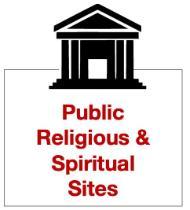
Public religious and spiritual sites provide spaces where people from the surrounding neighborhoods and the general public gather to cultivate a greater sense of belonging or for quiet reflection. These places may also include symbols of religious, spiritual, or cultural significance.
Sites in public places—parks, gardens, hospitals, school campuses, cemeteries, commercial plazas open to the public—that are not religious worship sites per se can nonetheless have religious or spiritual resonances. These may include statues of religious or significant cultural figures, memorials of events of religious or spiritual significance, plaques recognizing religious figures or communities, murals or other artworks in public buildings (often including government buildings) with religious content, or spaces set aside for practices of reflection or quiet contemplation that locals think of as religious or spiritual (e.g., water features like fountains that help to provide a sense of serenity).
Many institutional religious sites may also be considered “public” in the sense that they are generally located and built to be accessible to members and to people in the wider community. However, such institutional religious sites should most often be categorized as an institutional religious worship site.